Pencil Sharpening on Conan
Pencil Sharpening on Conan…
Pencil Sharpening on Conan Read More »
Just a quick note – actually: two.
First: It looks as if Staedtler will release a new sharpener next year. What makes it really interesting is the article number: 501 180. The article number of their current rotary (i.e. hand crank) sharpener starts with 501. …and number 180 is associated with another, very nice product from Staedtler. 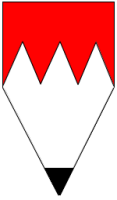
Second: I came across this article: The coloured pencil’s 180th birthday – a Franconian invention used around the world. [1]With such a title I couldn’t resist displaying my Franconian pencil logo again.
Unfortunately the original article is in German, but here’s a link to the Bing translation and to the Google translation. The article talks about Johann Sebastian Staedtler’s coloured pencil breakthrough in 1834.
References
| ↑1 | With such a title I couldn’t resist displaying my Franconian pencil logo again. |
|---|
…the sharpener called grenade, not a real grenade.
Or should that be ‘How not to restore a grenade’? – you’ll see why.
The age and the name of this sharpener even fit with the current 100th anniversary of Britain’s involvement in WWI, which is being commemorated on a national and on a local level – with local museums and libraries in and around Preston (where I live) taking part.
The grenade sharpener design has been around since 1847 [1]see Lexikaliker: Granate and is still being sold today. I got a modern one, which Lexikaliker got me five years ago when I wasn’t able to get one in the UK.
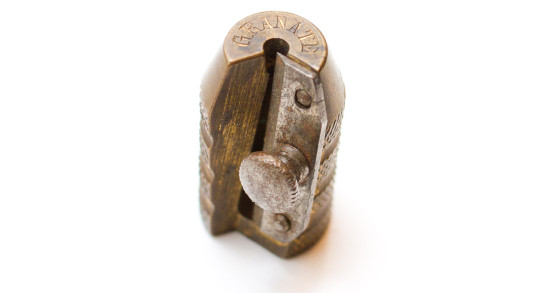
Cleaning
A few days ago I also got my hands on an old version – I was lucky enough to get one for a good price.
First task: clean it. I bought the metal polish used during a previous trip to Germany, after a tip from Lexikaliker on how to clean old brass.
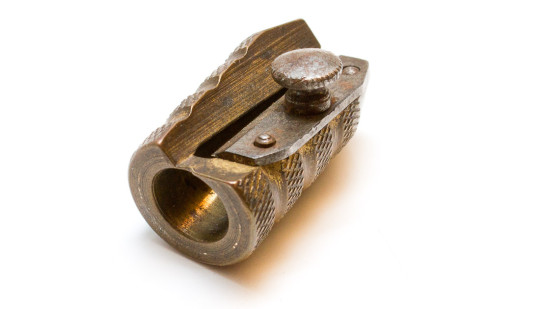
Problem
Unfortunately something went quite wrong. There was a band of oxidisation after I left the sharpener in the metal polish over night. It now looks as if there’s a dent where this band was. Brass is missing in this dent, which is difficult to see on the photos, but quite obvious in reality.

I have two ideas as to what might have caused this.
Ok. I got to live with my mistake now, but if I ever get another chance I will keep the blade and screw separate.
Next problem: The blade. It seems slightly too short to cut into the wood. I’ll talk about that another time.

References
| ↑1 | see Lexikaliker: Granate |
|---|
Restoring a grenade Read More »
Welcome to the 251st post.

This time: a pencil made from recycled money. My colleague Dr. Mitchell Larson saw this pencil while visiting another university and brought one back.
Recycled money
A quick search on the Internet shows that many British suppliers of promotional pencils stock this green, recycled pencil. I am not sure whether it’s made from recycled Pound notes (less likely) or whether the colour is supposed to indicate that it is made from recycled Dollar bills (more likely). This is probably the same pencil as the one seen on Pencil Revolution in 2006. In any case, the pencil doesn’t feel as if it’s made from pure, recycled cotton paper. It’s much too hard and dense for that. I’d speculate that it’s made from plastic banknotes if I wouldn’t think it’s made from Dollar bills. Another explanation for the plasticy consistency, one which seems more likely, might be that the consistency of the recycled notes is just not right to be made into a pencil – so the recycled material might have had to be mixed with another material. Maybe there’s an even more exciting explanation: maybe the recycled notes had to be mixed with another material to make it impossible to use this pencil to forge money. Lots of speculation, but in the end it doesn’t matter why: this pencil is much more similar to a Staedtler Wopex or to a BIC ecolutions evolution than to a pencil made from rolled paper, like the ones shown in the battle of the eco pencils.
The pencil itself is round. I mention this because there is an older, hexagonal version – the one made from $7.33 of recycled Dollars.

The lead
The lead behaves and feels similar to the BIC ecolutions evolution, it’s just a bit less waxy. It’s definitely worse than a Staedtler Wopex, it’s not as dark and more plasticy, but much better than the catastrophic pencils made from recycled CD cases, which are widely used as promotional pencils. I’m not even looking for the CD case pencils on purpose, but have already come across four different ones. Two of them were left by students in different rooms in our university. I can’t blame them for not wanting to write with these pencils.
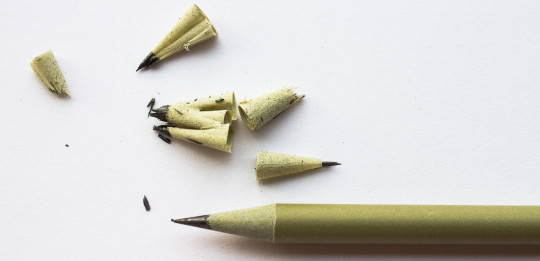
Sharpening
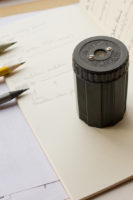
In a good sharpener, in this case the DUX 9207-N, sharpening the recycled money pencil is effortless. Despite being made from a material that seems quite a bit harder than wood the sharpener didn’t struggle at all. When sharpening the recycled money pencil in a ‘not so good’ sharpener or one where use has resulted in a blunt blade sharpening needs more effort than your average wood cased pencil.
Since we’re just talking about the sharpener anyway, the DUX 9207-N is a very nice sharpener, made from black Bakelite. As far as I know this sharpener has been first produced in the 1940s. You can sometimes see people on eBay trying to sell new versions of this sharpener as antiques. The DUX sharpens with an angle of ~20°. Please take the time to click on the picture of the sharpener to see the delicate, sophisticated pattern on the lid of the sharpener in higher resolution.
Overall
Some pencils made from recycled materials are truly awful. This pencil isn’t one of them. The fact that it’s made from recycled money makes it an interesting novelty. The lead is usable, even though it’S not as good as the best pencils made from recycled materials.
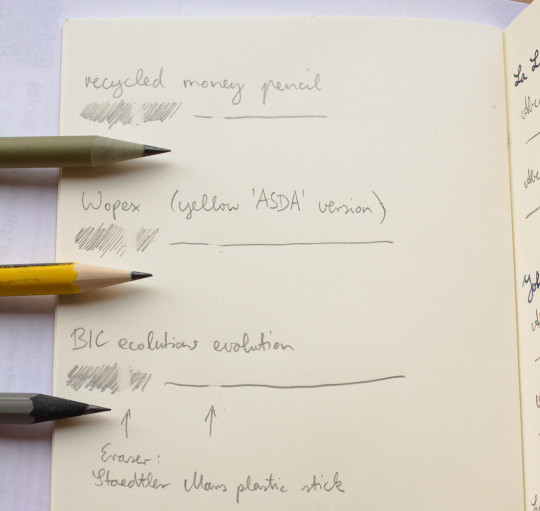
I’d like to thank Lexikaliker for getting me the Dux 9207-N sharpener. I couldn’t find it in any local shops.
I’d like to thank Dr. Mitchell Larson for the recycled money pencil.
A recycled money pencil has been recently mentioned in the Erasable podcast, probably in Episode 5.
Recycled money pencil Read More »
I guess I should stick to pencils, the clam clips blog post really wasn’t popular, so here’s a new blog posts about a pencil and a sharpener/eraser combo. The pencil side of today’s post is, to some extent, linked to an earlier blog post about the Amos Dixon Ticonderoga and to pencil talk’s blog post about Fila’s global pencils. I’ll be writing about Lyra’s Temagraph. The sharpener side of the post is linked to an earlier post about the Eisen 402.

The Lyra Temagraph
Temagraph
Assumed origin: from Greek thema + -graph: An instrument for writing about a topic, theme or proposition
The Temagraph has been available for some time now, but in the past it was only available under the Fila brand name. You can see pictures of the old Fila Temagraph at Lápis and Pencils and at pencil talk. After Fila (Italy) bought Dixon (USA) and Lyra (Germany) they started ‘adjusting’ their products, including the Temagraph. The Temagraph suddenly started to look pretty much like the Dixon Ticonderoga (metallic green font on a yellow pencil) and is now marketed [1]It’s advertising includes promises such as “The best designers choose the excellent lines of Temagraph pencils.” and “The best illustrators choose the clean line left by … Continue reading as a Lyra pencil, rather than as a Fila pencil.
Look
Two sides of the pencil are a labelled. The Temagraph side is labelled in metallic green. Opposite is the barcode side, labelled in black. The Temagraph has a end cap similar to the Noris, indicating lead hardness, but with a straight line around the corners.
Material
The FSC code on the packaging doesn’t leave any doubt about the Temagraph being linked to the Ticonderoga. The certificate is linked to the Beijing Fila Dixon Stationery Co., Ltd [2]Timberlines has further information about the Chinese manufacturer of these pencils. and shows that the pencil is made using Tilia spp., which includes many species of linden trees (also called lime trees or basswood).

Availability
Even though it is officially a Lyra pencil (and Lyra is/was a German brand) I have never seen this pencil in any shop in Germany. It dos however seem to be more popular in Fila’s home country Italy. When looking for the Temagraph on Amazon UK I could only find Italian sellers offering this pencil. Mine are from a local shop in Germany. They didn’t stock any, but a few years ago I asked them to order a few for me.
Performance
The Temagraph feels fairly smooth and puts down a very dark line. As you might have guessed from the fact that it’s a dark line – the lead rather soft, which means that point retention is not as good as it is with a normal pencil. In my case that means that I’m happy to use the Temagraph for writing the occaional sentence (think calendar entries), but I wouldn’t want to use it write a lot as it would need sharpening too often.
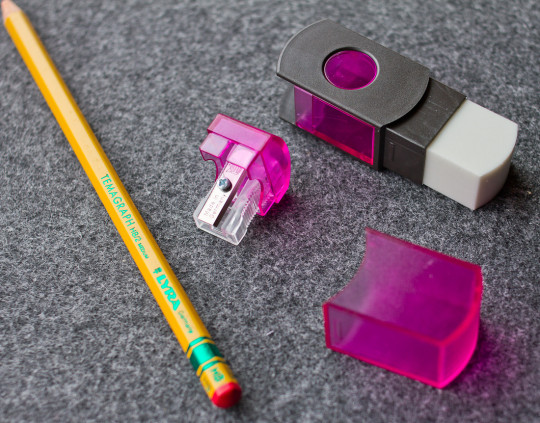
The Eisen 480
I sharpened the Temagraph with Eisen’s model 480. The Eisen 480 sharpens with an angle of approx. 21°. It’s a container sharpener that comes with an eraser, to some extent similar to the Faber-Castell Sharpener-eraser pen 18 44 01. The container for the shavings can be rotated and will lock in one of two positions: sharpener accessible and sharpener closed, to prevent shavings from falling out.

The eraser comes with a lid and fits exactly under the lid. Eraser performance is good. It’s a TPR (thermoplastic rubber) eraser that produces strands that roll together, to some extent similar to a dust-free eraser, but not as extreme, but eraser performance overall is no match for the excellent performance of the sharpener, which produces a nice, continuous strand of shavings with a thickness of about 0.2 mm. The blade is made in Baiersdorf, the container is made in Taicang, where assembly takes place, and the eraser is bought in.
You can find out more about the Temagraph at Lexikaliker.
The grey background in the photos (except the last photo) is from Atoma’s Alain Bertreau notebook. I placed the items in the A4 version of this notebook.
I bought the Temagraph in Germany, but can’t remember how much I paid for them.
I have received the Eisen 480 as a free sample from Eisen. Mr. Leistner provided further information. I don’t believe that, when I received the sample, Eisen was aware that I have a blog. I also don’t believe that not having paid for this sharpener has influenced my opinion of the sharpener in any way.
References
| ↑1 | It’s advertising includes promises such as “The best designers choose the excellent lines of Temagraph pencils.” and “The best illustrators choose the clean line left by Temagraph pencils! Superior quality, gold series, fine graphite for clean-cut lines, Temagraph pencils come with an extra-resistant and easy to sharpen and original green metal band indicating the grade.” Despite this promise the green band isn’t made from metal. I’m also not sure though what the green band is resistant to, why you would want to sharpen it. The green band doesn’t indicate the grade either. I’m not sure whether the best illustrators really choose the Temagraph, so like with a lot of advertising I choose not to believe this until I see proof supporting this statement. |
|---|---|
| ↑2 | Timberlines has further information about the Chinese manufacturer of these pencils. |
The Lyra Temagraph and the Eisen 480 Read More »